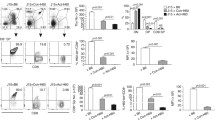Abstract
Herpes-simplex-virus (HSV) specific, H-2k-restricted, immune cytotoxic T lymphocytes also lyse noninfected H-2d target cells. Genetic mapping studies revealed that HSV-specific Dk-restricted CTL cross-react with allogeneic targets expressing Dd alloantigens. Cold target inhibition experiments indicate that only a minority of HSV-specific CTL mediate cross-reactive cytolysis. The data give an example of where the phenomenon of H-2-restricted versus nonrestricted responsiveness is not due to distinct subsets of T cells but solely depends on the antigenic determinants recognized.
Similar content being viewed by others
References
Alter, B. J. and Bach, F. H.: Speculations on alternative pathways of T lymphocyte responses.Scand. J. Immunol. 10: 87–93, 1979.
Bevan, M. J.: Killer cells reactive to altered-self antigens can also be alloreactive.Proc. Natl. Acad. Sci. U.S.A. 74: 2094–2098, 1977
Bevan, M. J. and Fink, J. P.: The influence of thymus H-2 antigens on the specificity of maturing killer and helper cells.Immunol. Rev. 42: 3–19, 1978
Billings, P., Burakoff, S. J., Dorf, M. E., and Benacerraf, B.: Genetic control of cytolytic T-lymphocyte responses. I. Ir gene control of the specificity of cytolytic T-lymphocyte response to trinitrophenylmodified syngeneic cells.J. Exp. Med. 148: 341–351, 1978
Binz, H. and Wigzell, H.: Shared idiotypic determinants on B and T lymphocytes reactive against the same antigenic determinants.J. Exp. Med. 142: 1218–1230, 1975
Burakoff, S. J., Finberg, R., Glimcher, L., Lemmonier, F., Benacerraf, B., and Cantor, H.: The biological significance of alloreactivity. The ontogeny of T-cell sets specific for alloantigens and modified self antigens.J. Exp. Med. 148: 1414–1422, 1978
Cantor, H. and Boyse, E. A.: Regulation of cellular and humoral immune responses by T cell subclasses.Cold Spring Harbour Symp. Quant. Biol. 41: 23–62, 1976
Doherty, P. C., Blanden, P. V., and Zinkernagel, R. M.: Specificity of virus-immune effector T cells for H-2K or H-2D compatible interactions: Implications for H-antigen diversity.Transplant. Rev. 29: 89–124, 1976
Doherty, P. C., Biddison, W. E., Bennink, J. R., and Knowles, B. B.: Cytotoxic T cell response in mice infected with influenza and vaccinia viruses vary in magnitude with H-2 genotype.J. Exp. Med. 148: 534–543, 1978
Finberg, R., Burakoff, S., Cantor, H., and Benacerraf, B.: Biological significance of alloreactivity: T cells stimulated by Sendai virus-coated syngeneic spleen cells specifically lyse allogeneic target cells.Proc. Natl. Acad. Sci. U.S.A. 75: 5145–5149, 1978
Gordon, R. D., Samelson, L. E., and Simpson, E.: Selective response to H-Y antigen by F1 female mice sensitized to F1 male cells.J. Exp. Med. 146: 606–610, 1977
Heber-Katz, E. and Wilson, D. B.: Sheep red blood cell-specific helper activity in rat thoracic duct lymphocyte populations positively selected for reactivity to specific strong histocompatibility alloantigens.J. Exp. Med. 143: 701–706, 1976
Jung, H., Pfizenmaier, K., Starzinski-Powitz, A., Röllinghoff, M., and Wagner, H.: Primary in vitro sensitization of virus-specific cytotoxic T lymphocytes.Immunology 34: 763–769, 1978
Kurrle, R., Röllinghoff, M., and Wagner, H.: H-2 linked murine cytotoxic T cell responses specific for sendai virus-infected cells.Eur. J. Immunol. 8: 910–912, 1978
Lindahl, K. D. and Wilson, D. B.: Histocompatibility antigen-activated cytotoxic lymphocytes. II. Estimates of the frequency and specificity of precursors.J. Exp. Med. 145: 508–522, 1977
Miller, R. G., Teh, T. S., Harley, E., and Phillips, R. A.: Quantitative studies of the activation of cytotoxic lymphocyte precursors cells.Immunol. Rev. 35: 38–58, 1977
Pfizenmaier, K., Jung, H., Starzinski-Powitz, A., Röllinghoff, M., and Wagner, H.: The role of T cells in anti-herpes simplex virus immunity. I. Induction of antigen-specific cytotoxic T lymphocytes.J. Immunol. 119: 939–944, 1977
Pfizenmaier, K., Trinchieri, G., Solter, D., and Knowles, B. B.: Mapping of H-2 genes associated with T cell-mediated cytotoxic responses to SV40-tumor-associated specific antigens.Nature 274: 691–693, 1978
Shearer, G. M. and Schmitt-Verhulst, A. M.: Major histocompatibility complex restricted cell-mediated immunity.Adv. Immunol. 25: 55–91, 1977
Simon, M. M. and Koszinowski, U.: Generation of effector cells from T cell subsets. 1. Similar requirement for Lyt 1 cells subpopulations in the generation of alloreactive and H-2 restricted killer cells.Immunobiology 156: 96–109, 1979
Simpson, E. and Gordon, R. D.: Responsiveness to H-Y antigen Ir gene complementation and target cells specificity.Immunol. Rev. 35: 59–75, 1977
Skinner, M. A. and Marbrook, J.: An estimation of the frequency of precursor cells which generate cytotoxic lymphocytes.J. Exp. Med. 143: 1562–1567, 1976
von Boehmer, H., Haas, W., and Jerne, N. K.: Major histocompatibility complex-linked immune responsiveness is acquired by lymphocytes of low-responder mice differentiating in thymus of highresponder mice.Proc. Natl. Acad. Sci. U.S.A. 75: 2439–2442, 1978
von Boehmer, H., Hengartner, H., Nabholz, M., Lenhardt, W., Schreier, M. H., and Haas, W.: Fine specificity of a continuously growing killer cell clone specific for H-Y antigen.Eur. J. Immunol. 9: 592–597, 1979
Wagner, H. and Röllinghoff, M.: T-T cell interactions during in vitro cytotoxic allograft responses. I. Soluble products from activated Ly 1+ T cells trigger autonomously antigen primed Ly 23+ T cells to cell proliferation and cytolytic activity.J. Exp. Med. 148: 1523–1538, 1978
Wagner, H., Pfizenmaier, K., and Röllinghoff, M.: The role of the major histocompatibility gene complex in murine cytotoxic T cell responses.Adv. Cancer Res. 31, in press. 1979
Zinkernagel, R. M., Althage, A., Cooper, S., Kreeb, G., Klein, P. A., Sefton, B., Flaherty, L., Strimpfling, J., Shreffler, D., and Klein, J.: Ir genes in H-2 regulate generation of antiviral cytotoxic T cells: Mapping to K or D and dominance of unresponsiveness.J. Exp. Med. 148: 592–606, 1978
Zinkernagel, R. M. and Doherty, P. C.: MHC-restricted cytotoxic T cells: Studies on the biological role of polymorphic major transplantation antigens, determining T cell restriction-specificity, function and responsiveness.Adv. Immunol. 27: 51–177. 1979
Author information
Authors and Affiliations
Additional information
This work was supported by the SFB 107 and the Stiftung Volkswagenwerk.
Rights and permissions
About this article
Cite this article
Pfizenmaier, K., Jung, H., Kurrle, R. et al. Anti H-2Dd alloreactivity mediated by herpes-simplex-virus specific cytotoxic H-2k T lymphocytes is associated with H-2Dk . Immunogenetics 10, 395–404 (1980). https://doi.org/10.1007/BF01561589
Received:
Issue Date:
DOI: https://doi.org/10.1007/BF01561589




